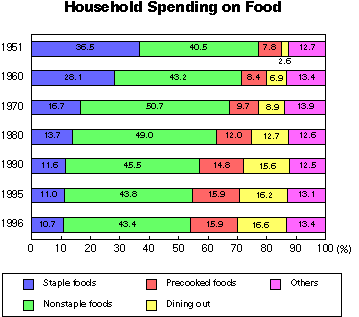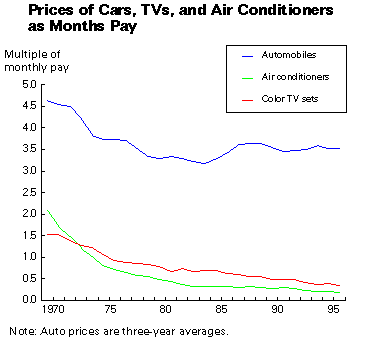

SCRUTINIZING SPENDING:
Survey Chronicles Postwar Consumption TrendsMay 15, 1997
The survey is unique in that it is based on the actual accounts kept by monitor households. Some salient trends the survey reveals are as follows.
A 4.6-Fold Jump in Living Standards
In 1948 the average household in a city of 50,000 or more spent 8,780 yen a month. In 1996 the figure was 333,763 yen--a 38-fold jump in nominal terms. The consumer price index rose approximately 10-fold during the same period, and the average number of household members declined from 4.8 to 3.3.
Thus the "consumption standard index," which measures real shifts in living standards by adjusting for price and other fluctuations, shows that a twofold improvement over 1948 levels was achieved 12 years later in 1960. The index tripled in 1969, and it quadrupled in 1979. In 1996 it was approximately 4.6-fold higher than in 1948.
Spending Smaller Shares on Essentials
Economic growth and higher living standards have affected the kind of items people buy. Shortly after World War II, most people were preoccupied with getting enough to eat. The Engel coefficient, measuring the share of expenditures spent on foodstuffs, was 63% in 1947. It returned to prewar levels of around 40% in 1962, and dropped below 30% in 1979. The share in 1996 was 23%.
Types of food items bought have also changed. In 1951, in the midst of the country's reconstruction efforts, 37% of food expenditures went to staples, such as rice. Precooked foods accounted for 8% and dining out for only 3%.
As increasing shares of women have entered the work force and a range of services have been introduced to facilitate household chores, the percentage claimed by staple items have dropped to a third of 1951 levels, reaching just 11% in 1996. Precooked foods, on the other hand, doubled to 16%, and the amount spent on dining out rose sixfold to 16%.
Another notable trend is the increased spending on services. In 1970, 73% of household expenditures went for purchases of goods. But with the economy becoming increasingly service-oriented, the share fell to 60% in 1996; this was accompanied by a corresponding rise in spending on services.

Back in 1963, when the nation was caught up in its first-ever auto boom, average car purchases were equivalent to 7.5 months of a full-time worker's salary. In 1996 the average was just 3.7 months.
Similarly, the average price of air conditioners dropped from 2.7 months of pay to 0.35 months, and that of color TVs dropped from 2.7 months to 0.19 months. This means it is now possible to buy three to five air conditioners or TV sets with a single month's paycheck.

According to a 1996 Economic Planning Agency report on consumer prices, for instance, prices in Tokyo overall were 1.59 times those in New York, 1.52 times those in London, 1.34 times those in Paris, and 1.35 times those in Berlin. The only items that were cheaper in Tokyo were health and medical costs (0.90 times prices in New York); schooling expenses (0.71 times London levels); consumer durables (0.94 times prices in Paris and 0.92 times those in Berlin); and water supply and sewerage (0.72 times Paris standards and 0.47 times those in Berlin). Tokyo had the highest prices for all other survey items.
The EPA report considered both purchasing power parity and exchange rates. Because of the yen's devaluation since the last survey, though, Tokyo's prices are probably somewhat lower today. But a weaker yen means higher price tags for imports, and the impact on the price differential may be minimal.
The only way to significantly narrow the price gap with other countries is through deregulation and other policy initiatives. The government is currently introducing a number of reforms to bring prices in line with international norms.
| New York | London | Paris | Berlin | Geneva | |
|---|---|---|---|---|---|
| Foodstuffs | 1.77 | 1.99 | 1.78 | 1.89 | 1.24 |
| Consumer durables | 1.47 | 1.15 | 0.94 | 0.92 | 0.93 |
| Clothing, footwear | 1.93 | 1.81 | 1.50 | 1.35 | 0.99 |
| Other products | 1.54 | 1.41 | 1.12 | 1.15 | 0.98 |
| Energy | 2.17 | 1.91 | 1.32 | 1.13 | 1.08 |
| Water supply, sewerage | 2.02 | 1.16 | 0.72 | 0.47 | 0.93 |
| Transport | 1.72 | 1.37 | 1.28 | 1.32 | 1.08 |
| Telecommunications | 1.23 | 1.19 | 1.07 | 1.01 | 0.87 |
| Insurance, medicine | 0.90 | 2.20 | 1.60 | 3.40 | 0.31 |
| Education | 1.02 | 0.71 | 1.26 | 1.15 | 0.54 |
| Rent | 2.06 | 1.59 | 1.76 | 1.26 | 1.73 |
| General services | 1.25 | 1.28 | 1.02 | 1.11 | 0.86 |
| Total | 1.59 | 1.52 | 1.34 | 1.35 | 1.02 |
 Edited by Japan Echo Inc. based on domestic
Japanese news sources. Articles presented here are offered for reference purposes and do not
necessarily represent the policy or views of the Japanese Government.
Edited by Japan Echo Inc. based on domestic
Japanese news sources. Articles presented here are offered for reference purposes and do not
necessarily represent the policy or views of the Japanese Government.| MOFA Home Page | JIN Home Page |